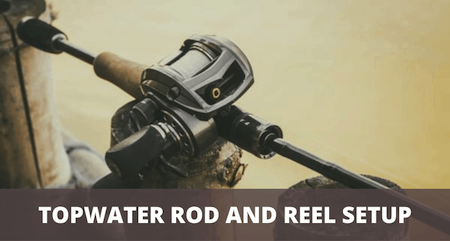Topwater Rod And Reel Setup (Explained)
UPDATED 17 MAY 2023
by Robert Ceran
Fishing topwater lures is very different from other other fishing techniques in two main ways:
- Most topwater lures are large and come with 2-3 big treble hooks.
- Topwater fishing involves pointing your rod tip down to the water surface while you work the lure by twitching the rod tip.
Because of these two characteristics, it’s important to use the right rod and reel setup to get the best results. So what is the ideal setup for this kind of fishing?
Here’s the quick answer:
The ideal rod and reel setup for most topwater fishing applications consists of a 6’6” medium fast casting rod, combined with a baitcasting reel with gear ratio 7.1:1, spooled with 15-20 lb test braid or monofilament (50-60 lb test braid if you’re fishing in heavy cover).

Now let’s dive into the details, and take a closer look at the ideal setup to use for topwater fishing.
All of the specs given below are for a casting rod and reel, but you can also apply them to a spinning setup, if that is your preference.
Topwater rod setup
- Length: 6’4” to 7’
- Power: Medium
- Action: Fast
Length
As mentioned above, topwater fishing requires pointing your rod tip down to the water surface, and twitching the rod tip to give the lure a jerking movement during retrieval.
Because of this, you really don’t want to use a rod that’s too long, since this length is very awkward for this style of retrieval.
Depending on how tall you are, anywhere between 6’4” and 7’ is a good choice.
If you’re interested in getting a rod that fits these specifications, check out our review of the best topwater rod.
You may also want to get a rod with a relatively short handle, since this is more comfortable when holding the tip down during retrieval, as the rod butt tends to stick into your belly.
Power
Topwater lures tend to be on the large side, and usually have two to three big treble hooks on them.
The problem with these lures is that it can be very difficult to set the hook, since you need the treble hooks to successfully penetrate the hard mouth of a bass.
Your hook-setting ability is directly affected by the power of your rod (which is a measure of how easily the blank bends under pressure).
If you’re using a heavy power rod (which is very stiff, and doesn’t bend easily) with treble hooks, it’s unfortunately very common that you’ll end up ripping the lure right out of the mouth of a bass before the hooks can penetrate successfully.
This is a very frustrating way to lose fish.
Because of this, it’s best to use a medium power blank, which is soft enough to have some flex during the hook setting process.
That way, when you set the hook, it takes a little more time for the force to be propagated all the way to the hooks, which gives them enough time to penetrate the bony mouth of a bass.
Another advantage of this is that this type of topwater rod setup also gives bass a little more time to get the lure fully inside its mouth before you set the hook.
Action
The best action for topwater rods is fast action. This provides the perfect amount of tip stiffness to control lure movement very precisely during retrieval, while still being soft enough to help you to set the big treble hooks without ripping them out of the bass mouth.
Depending on your personal preference, you can also choose a topwater rod setup with a moderate-fast action model, but will have to adjust your technique accordingly.
Keep in mind that the faster the action of your rod, the more time you need to give a fish to get the lure completely inside its mouth before setting the hook.
This takes a little practice, because the instinctive response of every angler is to whip up the rod and set the hook as soon as you see a fish grabbing the lure.
It’s really worth working on this skill, since the ability to delay your strike by a second or two is one of the key secrets to catching more fish.
Ideal topwater reel specs
- Reel size: 100
- Gear ratio: 7.1:1 to 7.3:1
The ideal baitcasting reel for topwater is a 100 (medium) sized model with a relatively fast gear ratio of 7.3:1.
While most lure retrieval techniques for this type of fishing are quite slow, you need a fast reel to pick up the slack when you get a blowup from a bass grabbing the lure.
Another great advantage of having a faster reel is that you can quickly retrieve your lure so you can cast it again to a different location where you’ve just spotted bass activity.
Also, these lures are very often fished close to cover, including laydowns, lily pads, and log fields. In those situations you really want to have a reel that’s fast enough to pick up slack very quickly, so you can haul a baig fish away from the cover instantly after setting the hook, to avoid getting your line snagged.
Best fishing line to use for topwater
The ideal choice of fishing line for topwater is either braided line or monofilament. Both of these line types float on the water, which is essential for this type of fishing. This also is why you should avoid fluorocarbon, which sinks in the water.
The best pound test strength to use for your line is determined by how close to cover you’ll be fishing. If you’re going to be fishing right in the middle of heavy cover (such as log fields or dense lily pads), and there’s a good chance of hooking big bass, you should spool heavy braid of up to 40 or 50 lb.
On the other hand, if you’re throwing your lures close to cover, but not right into it, 15-20 lb test is fine, and if you’re fishing in open water, 12 lb test is strong enough.
The choice between braid and monofilament depends on the water visibility, and on how shy the bass are. If the water is clear and the bass are finicky biters, monofilament is the better choice because it has less visibility.
In that case you could also use a braid main line tied to a monofilament leader. The advantage of this setup is that the braid has better casting performance, while the monofilament leader is harder for the bass to spot in the water.
